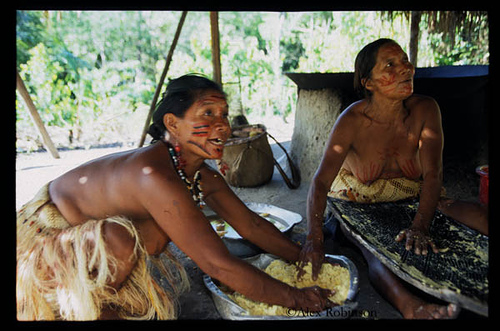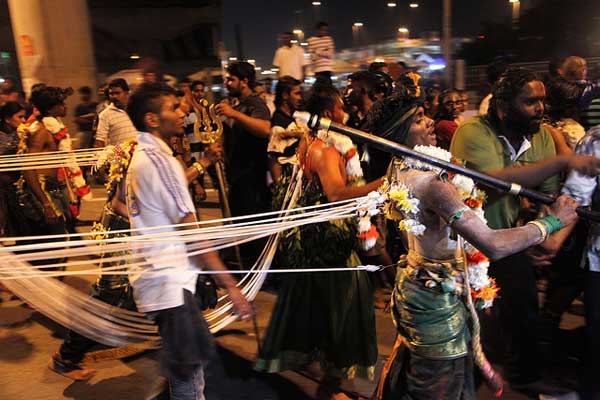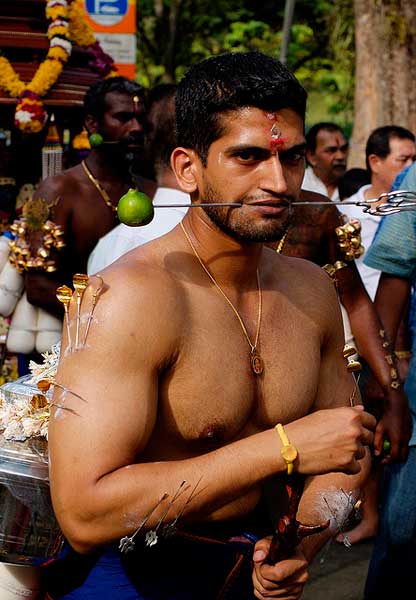Thank you very much for following me on my page ... this day end this blog !!! Nice vacation ... MERRY CHRISTMAS !!! bye.....
viernes, 5 de diciembre de 2014
jueves, 4 de diciembre de 2014
Tukanas (Colombia).
La Festa das Novas Flies is the rite of passage into womanhood used in this tribe Northwest Amazon. It happens when the first period, after which it remains isolated the girl for about 8 weeks in a room of the house built for this purpose is coming.
During this period you will be led to believe that is initiated in the underworld and will be attacked at any time by a demon named Noo. To complete the rite the other inhabitants of the house venture into that room disguised with masks and hoods into believing they are incarnations of Noo. After that, the girl's body is painted white so as to protect the devil, taking it to the third morning of that room like a real woman.
miércoles, 3 de diciembre de 2014
Swallowing Sperm...
The Sambia believe that men and women are born with a TINGU. The tingu is the body part that allows procreation. A woman tingu ready to play when the first menstruation occurs. In contrast, men are born with their dry tingu and the only way to fill it with the "male milk" which is nothing but the semen of other sexually mature men. They believe that drinking male scent of other men will make the boys are strong and virile. That's why in the privacy of the forest, a young will perform oral sex to young, unmarried usually between 13 and 21 years. Participants are advised to "drink the male essence" in the widest possible to obtain more strength.
Around age 13, a young initiates puberty and begins a new stage with her too. The ritual of nasal bleeding and some repeated blows to purify the young man from that time, is considered mature and can provide "male milk" young children going starting their way to manhood.
In the Sambia culture, with semen, the spirits of the ancestors transmitted, life is created, the body develops and strengthens. The age of individuals is producing a social hierarchy in which women are relegated to a second term because wearing the semen of men, and that children should eat to produce sperm. Mature women naturally because their bodies contain a body of menstrual blood accelerates development.
martes, 2 de diciembre de 2014
Thaipusam: A Hindu festival in Malaysia
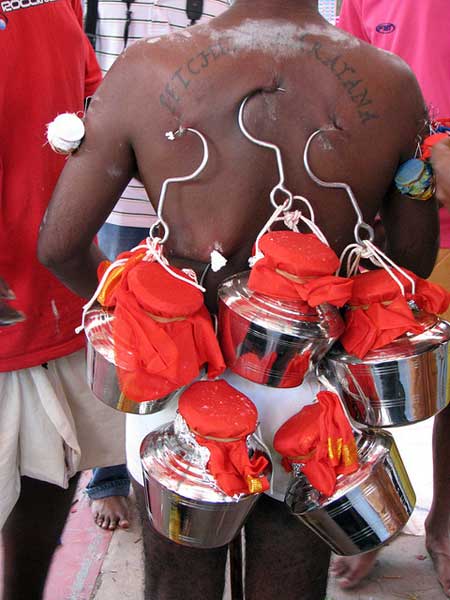 The Thaipusam is celebrated in several cities in Malaysia, especially in Kuala Lumpur, the capital, which gathers around a million people to give thanks and show your appreciation to Murugan son of Lord Shiva. The most impressive festival is part of flagellation in which participants most devoted cheeks and tongue with small iron bars are drilled and hooks dig into the body (with which even pull carts) without apparent pain without just bleed. Besides these piercings also carry over iron structures with figures or symbols of gods above (called Kavadi) weighing tens of kilograms and are nailed to the body.
The Thaipusam is celebrated in several cities in Malaysia, especially in Kuala Lumpur, the capital, which gathers around a million people to give thanks and show your appreciation to Murugan son of Lord Shiva. The most impressive festival is part of flagellation in which participants most devoted cheeks and tongue with small iron bars are drilled and hooks dig into the body (with which even pull carts) without apparent pain without just bleed. Besides these piercings also carry over iron structures with figures or symbols of gods above (called Kavadi) weighing tens of kilograms and are nailed to the body.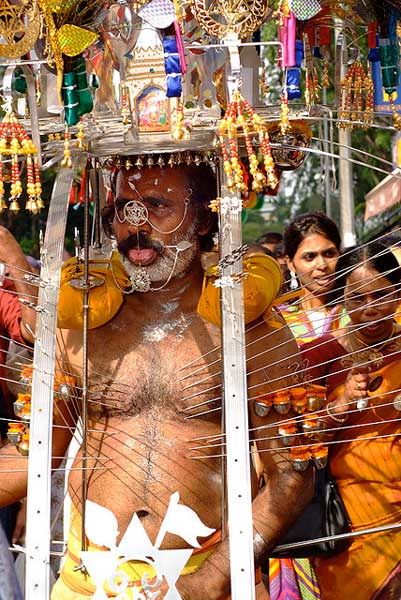 Kavadi Each carrier has a group of assistants that follow, you are encouraged and dance beside her. They say no pain thanks to state of trance found after preparation by which participants must pass, two days fasting, meditating and praying before beginning the ceremony.
Kavadi Each carrier has a group of assistants that follow, you are encouraged and dance beside her. They say no pain thanks to state of trance found after preparation by which participants must pass, two days fasting, meditating and praying before beginning the ceremony.
The piercings, facts on the tongue and in the mouth, is to show that the pilgrim has temporarily given up the ability to speak to concentrate on their god and show how they have left their fate in their hands to protect you from feeling any pain or bleeding. Also to remind of transience or temporality of the physical body in contrast to the permanent spiritual life of truth. Your goal is to escape from this cycle to reach the spiritual universe.
The pilgrimage ends once they reach the Batu Cave (on the outskirts of Kuala Lumpur) and do their last dance with the energies that make them fit after hard day. Now they are ready to return to their daily lives and try to consolidate the lessons learned during the ceremony.
lunes, 1 de diciembre de 2014
Mourning Ritual Shiites Muslims
In the month of Muharram Muslim Shiites remember with mourning the death of one of its most important leaders.
Until here everything is normal, what is really strange is when all participants begin to beat his chest with his hands and then cut with knives and other sharp objects.
The Ashura festival is celebrated throughout the Muslim community, but is a central Shiite religious commemoration.
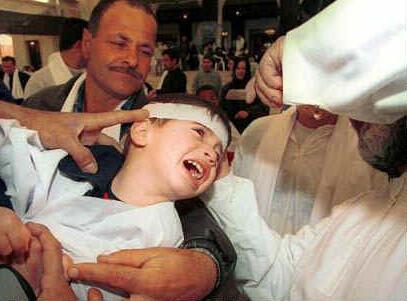 The festival falls on the tenth day of Muharram, the first month of the Muslim lunar calendar, and it recalls the Islamic world a voluntary fast when Noah left the ark and the salvation of Moses from the Egyptians by God's.
The festival falls on the tenth day of Muharram, the first month of the Muslim lunar calendar, and it recalls the Islamic world a voluntary fast when Noah left the ark and the salvation of Moses from the Egyptians by God's.
The Shiites also remember the martyrdom of Hussein, grandson of Prophet Mohammed, occurred in 680 in the city of Karbala, which is in the current Iraqi territory.
To honor him, thousands of men and women dressed in black march through the streets beating their chests and chanting. They also perform rituals of mourning and passionate recreations of martyrdom: there are those who emulate the function of Hussein flagellation with chains or cutting his forehead until blood runs them through the body.
 Some Shiite leaders try to discourage bleeding, saying it creates a bad image of their faith. In return, he proposed to the faithful donate blood.
Some Shiite leaders try to discourage bleeding, saying it creates a bad image of their faith. In return, he proposed to the faithful donate blood.
In Islamic antiquity, the Shia were a political faction that supported Ali, son of Muhammad and the fourth caliph (temporal and spiritual leader) of the Muslim community.
Ali was killed in 661 and his main opponent, Muawiya, became caliph. It was this murder that ended up causing the Great Schism that divided Muslims Shiites and Sunnis.
Muawiya was succeeded by his son Yazid, but Ali's son, Hussein, refused to accept its legitimacy, sparking a confrontation between them.
Hussein and his followers were massacred in battle near Karbala in the year 680. The deaths of Ali and Hussein gave rise to the Shia cult of martyrdom. Today, the Shiites are about 15% of the Muslim population in the world.
domingo, 30 de noviembre de 2014
Fifteen birthday!!!
The celebration marks the transition from girl to woman's quinceañera. It serves as a way to recognize the girl in question has reached maturity. The celebration however varies greatly across countries. However, the Quinceañera not mean that the girl in question is now an adult because this can vary according to the laws of each country.
In Mexico, for this occasion, the quinceañera is made up and headed for the event, leaving the conventional makeup and hair, and wearing a dress with the colors you chose the quinceañera.
 In the Mexican tradition, if the teenager is Catholic, the festival begins with a Mass of Thanksgiving, which also is venerated the Virgin, for the reason that at that age it was announced that he would have Jesus. The teenager attends Mass with (usually striking and creative, hinting at some sort of princess) formal dress color she chose previously (usually pastel shades or intense), where a medal is awarded for a sponsor or his godmother, being previously blessed, accompanied by her parents, godparents (sometimes the christening) and chamberlains. After Mass the families and friends of the quinceañera will deliver holiday gifts, and quinceañera leaves her bouquet on an altar to the Virgin Mary. A Mass is followed by a party at the quinceañera or banquet dining, casino, touched or ballroom, reserved for the occasion. In the quinceañera party usually danced some waltzes with his chamberlains.
In the Mexican tradition, if the teenager is Catholic, the festival begins with a Mass of Thanksgiving, which also is venerated the Virgin, for the reason that at that age it was announced that he would have Jesus. The teenager attends Mass with (usually striking and creative, hinting at some sort of princess) formal dress color she chose previously (usually pastel shades or intense), where a medal is awarded for a sponsor or his godmother, being previously blessed, accompanied by her parents, godparents (sometimes the christening) and chamberlains. After Mass the families and friends of the quinceañera will deliver holiday gifts, and quinceañera leaves her bouquet on an altar to the Virgin Mary. A Mass is followed by a party at the quinceañera or banquet dining, casino, touched or ballroom, reserved for the occasion. In the quinceañera party usually danced some waltzes with his chamberlains.
Other rituals, such as the latest toy, based on the Mayan tradition that this possession would be the last object for use by children would use are also performed, since by then her marriage would be next; and also of the shoe, where the father of the teenager changes his shoe floor by one high heels, which also symbolizes the passage to adulthood.
sábado, 29 de noviembre de 2014
Tibetan funeral.
"Burial in the clouds"

The Tibetans, either by necessity or beliefs, do not bury or cremate their dead, except for those under 18, pregnant women and killed by an infectious disease, the rest are delivered in the high peaks to the birds carrion. Vultures, "daikinis" are angels dancing enter clouds and be responsible for perpetuating the cycle of life, just as they do with other species with which we share our planet.
Whereas the Tibetans believe in reincarnation, the body of the deceased is considered by them as an empty container without any spiritual value.

When someone dies, for three days lamas monks pray their songs with passages from 'The Book of the Dead ", helping the soul of the deceased to cross the 49 levels of" bard "intermediate state that precedes the reincarnation wheel life. Once completed this, the family gather somewhere in the remote mountains. The celebrant of the ritual, with a very sharp knife, cut the flesh and muscles of the deceased before letting the vultures swoop on him, so that your work more quickly and easily. In a few minutes, all soft tissues and bones disappear targets are scattered over several square meters.

At that time, all traces are again collected and on a rock, with ax and knife again be crushed and mixed with flour called "tsampa" and, again, is delivered to the vultures, it may not they leave absolutely nothing, ending its function and increasing again to the clouds.
The funeral is over and all return to their homes.
viernes, 28 de noviembre de 2014
Easter in Taxco...
One of the most important tourist attractions that the state of Guerrero is the celebration of Holy Week in Taxco.
From 40 days before Holy Week ceremonies are held on the occasion of the Six Fridays of Lent, with each parish one day: the first Friday Tecalpulco; the second to Acamixtla; the third to Tehuilotepec and Taxco; the fourth to La Veracruz; the fifth, is performed in Atzala; and, sixth, in Paintla.
Begins with Sunday called Carnival, secular holiday that represents the wildness and farewell to the pleasures of the flesh; formerly was celebrated with great enthusiasm by young people who came together in the Guerrero park or garden Borda and, amid a shower of shells painted in colors and filled with confetti, dancing entertained by a local orchestra.
On Wednesday following the Sunday of Carnival is Ash day Lenten season proper starts. Local faithful come off early to church for the priest, with the ash of burnt relics, imposes the sign of the cross on the forehead and remember every person the origin of our humanity: "Dust thou art and to dust you will become. "
Palm Sunday or Easter commemorates the triumphal entry of Jesus into Jerusalem, among a crowd cheering him with olive branches, palms and flowers; and Holy Week begins. Early on, the faithful are concentrated in the town of Tehuilotepec where the procession started.
From Easter Monday, the faithful began a series of processions that take place at night, starting from the other temples of the city or even in some nearby town; to the sound of the clarions, walk, with images of their respective chapels.
The Holy Tuesday corresponds to the Procession of Souls and leads San Nicolás Tolentino, a sculpture of similar proportions to a human, wearing only a discovered face black skirt and a halo on his head, crucifix and rosary in hand, with clear evidence flogging and outbreaks of blood on the back. Men wear face covered with a black hood called hood; go barefoot, dragging chains, and bare torso; flagellants carry a wooden cross 3 of 2 m and 6 kg, a rosary in one hand and in the other a discipline made with horsehair and nails with whipping their backs, they look macerated and bloody. Women go in another group; covered completely black and barefoot walk on the forearms bent carrying a wooden crucifix and a rosary.
The Holy Wednesday a stage of "Mount of Olives" in the atrium of the parish of Santa Prisca and San Sebastián is placed, and locals flock with birds, parrots and parakeets in cages; to 21.00, the procession leaves the Holy Trinity from the temple that bears his name; is accompanied by the Apostles, Christ of the Silversmiths, San Judas Tadeo, Jesus the Good Shepherd, the Lord of Mercy.
On Holy Thursday, the procession of the community Xochula, performed the symbolic ceremony of the Washing, where Jesus, represented by the priest washes the feet of his disciples and invites them to participate in the Last Supper, celebrated and the sacraments of Penance and the Holy Eucharist. In the porch of the temple Arrest shown, by local actors, and the procession headed who plays Judas Iscariot starts.
On Good Friday the Sermon on the judgment of Jesus is read at 6.00 am; at 11.00, the Procession of the Three Falls, part of the Cathedral of St. Nicholas is organized. At 13:00 Jesus is crucified, at 16:00 we proceed to the Descent of the Holy Body and returned to the Convent of San Bernardino de Siena. At midnight, the Procession of Silence begins.

On Holy Saturday the faithful to observe, all day, absolute silence as a sign of mourning and sadness at the death of Jesus requested. At night, in the church of Santa Prisca and San Sebastián, there solemn Easter Vigil Mass; at 00:00 Mass of Resurrection, where the Lord's image appears dressed in a white robe and Gloria opens held; Roman soldiers who remained in the court for the faint fall
impact.
Easter Sunday is compulsory to attend Mass, and merchants selling meat again given away to their customers batons, flags, pop Zompantle and many curiosities.
jueves, 27 de noviembre de 2014
MATIS HUNTING TRIALS BRAZIL
Once the boys prove themselves able to withstand these trials, they are treated to performing them before every future hunt they partake in.
1. The first stage involves dumping bitter poison directly into their eyes allegedly in order to improve their vision and enhance the senses.
2.The next series of trials includes beating and whippings, to show their strength.
3. The trial concludes with inoculation of the small poisonous frog. After burning an area of the skin, the frog toxin is injected with the use of a wooden needle.
Two marks are then burned onto the skin of the participant, the blister popped and the toxin (mixed with human saliva to activate it) applied. Although not hallucinogenic, the psychological response is very intense and the physical response absolutely dramatic, it’s a total stomach purge.
4.Finally to demonstrate the strength of men are ready to go hunting.
The poison is said to increase strength and endurance, however, these enhancements must come after the unbearable lightheadedness, vehement vomiting, and violent relieving of the bowels.Once the boys prove themselves able to withstand these trials, they are treated to performing them before every future hunt they partake in.
miércoles, 26 de noviembre de 2014
Chinese Wedding.....
If something predominates in Chinese weddings is the color red, for them I unequivocal symbol of love and prosperity; is in dresses spouses, decorations, invitations or gifts wrappers.
Throughout the marriage process begins with the entry into action of an intermediary between the families, who takes care of all the formalities of betrothal. After bringing gifts to the parents of the bride and get data about the birth of the young. An expert decides whether astrologically marriage is thriving and viable, and if so the groom's parents provide details about the birth of their child, so that her in-laws carry out an identical astral comparison.
Both families evaluate the tune of their children together, attending numerous social, educational and personal aspects. The wedding celebration is decided, begins the onerous exchange offerings and gifts between both families, during which are always better rewarded parents of the bride, who ultimately choose the date of the ceremony date.
The bride prepares for the big day in a secluded room, surrounded by the closest friends and singing laments and cries over the loss of his family. The groom, meanwhile, handles the day before the wedding to install the bridal bed, while the execution itself usually does a person with many children to give them luck.
 Her hair as a symbol of initiation into adulthood is arranged, dressed in red, is refined with rituals of good luck, and once ready waits for the procession from the house of her future husband. It also appears red dress, having undertaken certain ceremonies before the family altar, accompanied by a child who symbolizes good luck for your future offspring, including music and dance. Once home of the bride, dinner and is awarded new gifts. At this point the roles are reversed, and the bride began his march to the groom's house, where he can finally discover the red scarf that covered his face with his fiancée, after another series of rituals.
Her hair as a symbol of initiation into adulthood is arranged, dressed in red, is refined with rituals of good luck, and once ready waits for the procession from the house of her future husband. It also appears red dress, having undertaken certain ceremonies before the family altar, accompanied by a child who symbolizes good luck for your future offspring, including music and dance. Once home of the bride, dinner and is awarded new gifts. At this point the roles are reversed, and the bride began his march to the groom's house, where he can finally discover the red scarf that covered his face with his fiancée, after another series of rituals.
The newlyweds go to the family altar to honor the ancestors and some other god, and there also share certain foods. They are then taken to the bridal chamber, in whose bed is aposentan and receive guests for one, two or even three days. Thereafter, the groom can go to the house of her in-laws as a guest.
martes, 25 de noviembre de 2014
Hindu Ritual.
Based on a series of social-religious practices and beliefs that go back to 2000 BC, the rite of marriage is a union that represents the "samskara" (sacred trust). Are always present two of the fundamental pillars of Hinduism: reincarnation and universalism.
The whole ceremony revolves around the "Brahman", the great religious authority (the traditional religion of India, believe in the absolute power of God Brahman); This ceremony is full of symbols and practices designed to teach the couple lessons for their future life in common purpose. The three basic rituals of this ceremony are: the ritual "homa" of offering to the fire; the "panigrahena" indicating the bond of union of the couple; the ritual "satapadi" which consists in achieving seven laps they should give the couple around the sacred fire. By completing these seven times, get used to chant mantras and read some scriptures, to invoke the blessings of the union of the couple.
The great wealth of this ritual ceremonial wedding is complemented by a rich and colorful costumes of the couple. The bride usually wear red, with multiple ornaments and embroidered in gold thread and richly dressed in jewels and beads. The groom dresses up like a locker holiday, embroidered cotton.
When meeting the couple, a wreath is exchanged, a sacred passages are read, and generally, a series of amulets are exchanged. The groom, as a token of acceptance of the bride, tie a garland around the neck of the bride as a symbol of fidelity and happiness. The groom, to indicate the new state of the bride, spray your hair with a red powder, which indicates that this woman is already married. Once married, the couple receive the "rain" of rice as a symbol of prosperity.
As tradition dictates this ritual of marriage has three main objectives:
 1. "Dharma" Having the presence of another person to fulfill their religious duties.
1. "Dharma" Having the presence of another person to fulfill their religious duties.2. "Praja" whose purpose is to have offspring.
3. "Krama", having a partner for sexual pleasure.
Welcome again to my blog!
This time we will discuss the importance of certain ceremonies around the world. I hope you like this topic .....
Suscribirse a:
Entradas (Atom)


